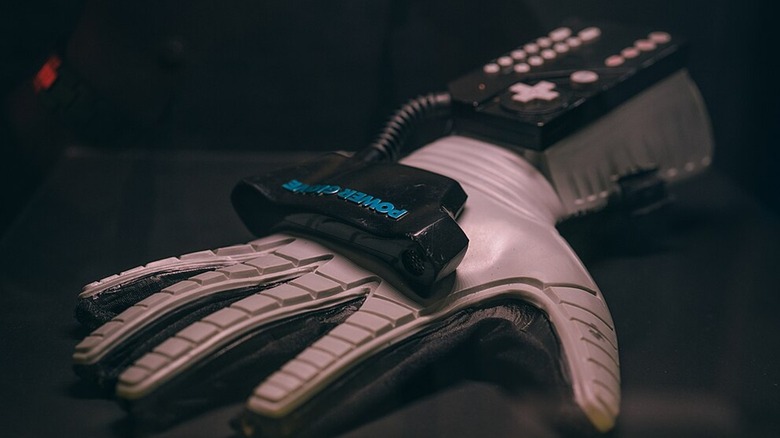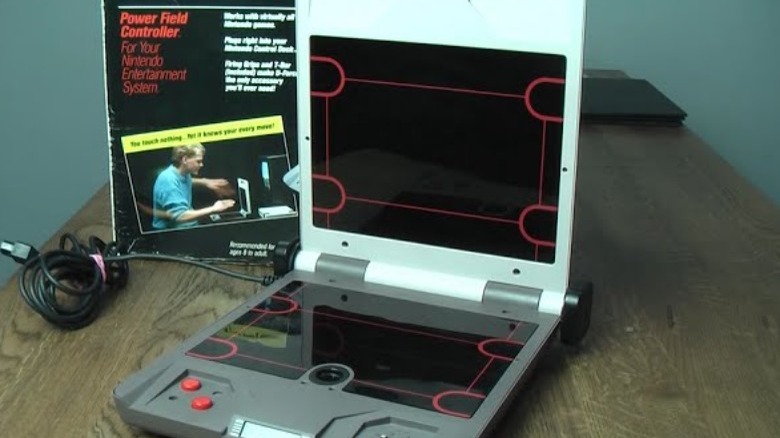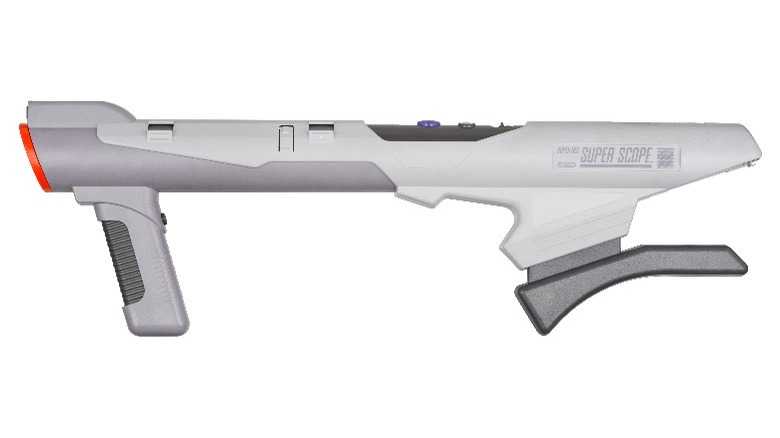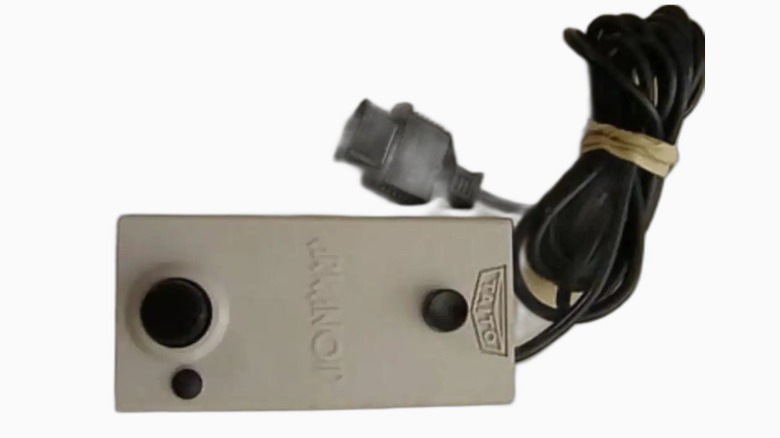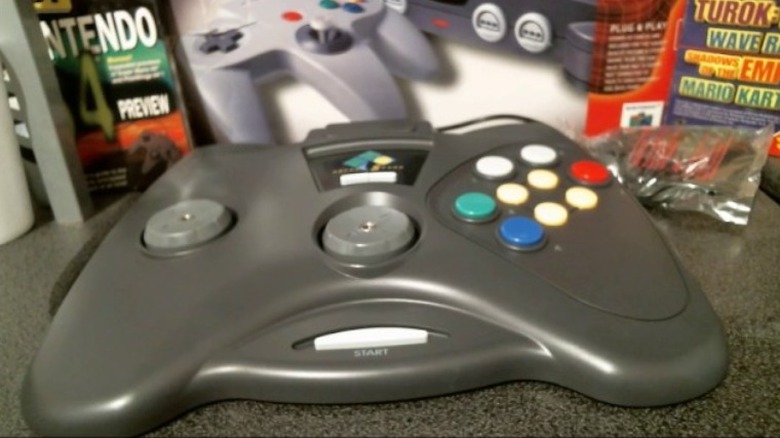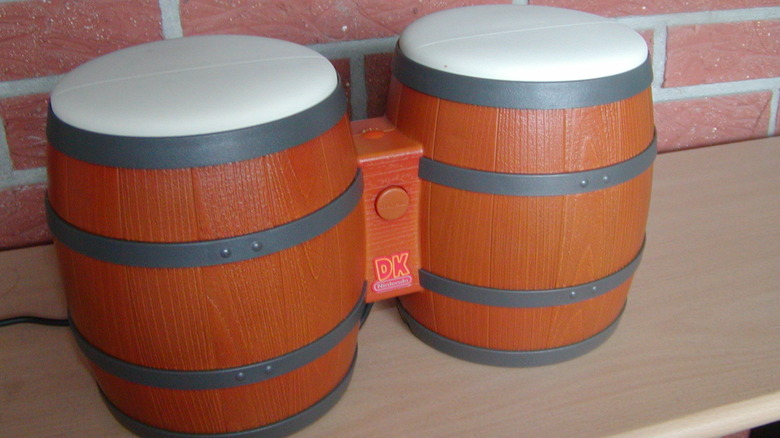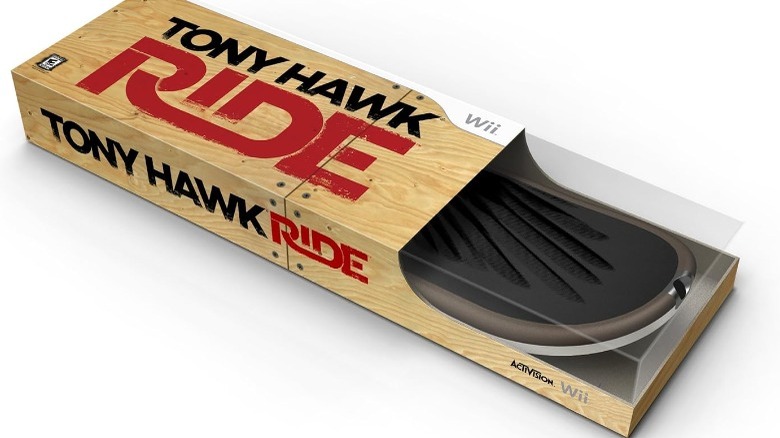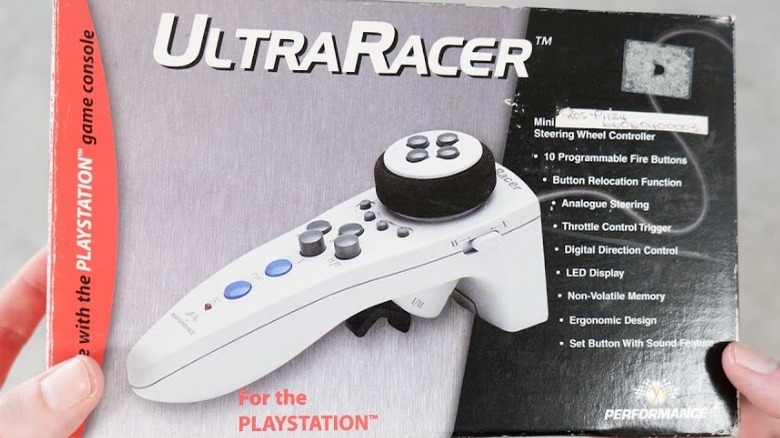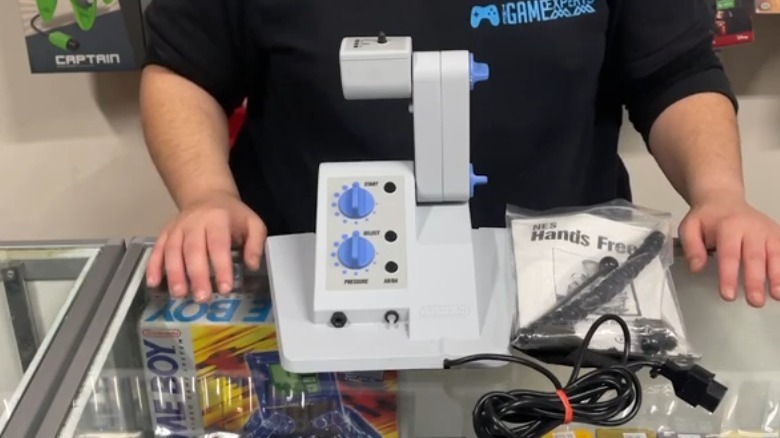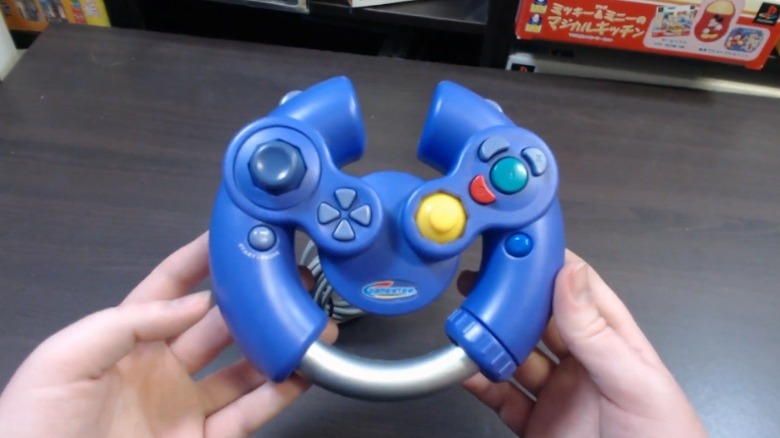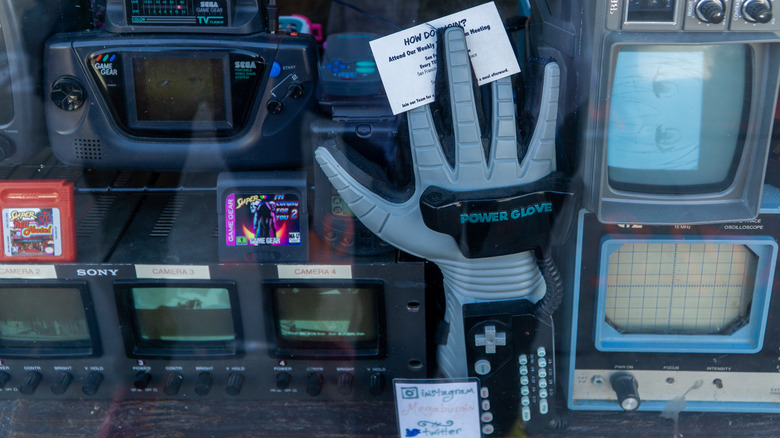10 Of The Strangest Nintendo Controllers We've Ever Seen
Video game controllers have evolved a lot since their initial introduction. In fact, the first gamepads used to translate user input into on-screen action are almost unrecognizable compared to what gamers use today. Nintendo, in particular, has often been at the forefront of innovation and invention when it comes to how game controllers have changed over the years, introducing many new features that have gone on to become standard in the industry.
However, not every experiment was a success and some Nintendo controllers didn't catch on like its most popular products. For every hit like the Wii Remote or Joy–Con, there's a baffling miss that makes you wonder how anyone even came up with the idea. Maybe the shape and design was wildly impractical or perhaps the features of the controller were just too weird for most players.
And while Nintendo itself has been responsible for creating some of the most bizarre gaming controllers, third-party hardware manufacturers have contributed a lot of strangeness over the years too. Check out these weird controllers made for Nintendo platforms.
[Featured image by Marcin Wichary via Wikimedia Commons | Cropped and scaled | CC BY 2.0]
Brøderbund U-Force
Long before Sony started creating strange controllers for its PlayStation consoles, Nintendo had already developed and released several bizarre controllers of its own. However, the success of the NES also meant that third-party manufacturers became interested in producing controllers and accessories. This would allow them to cash in on an already established fan base and one example of this was Brøderbund, a company known for creating video games and education software.
Brøderbund launched the U-Force in 1989 for the NES. Like the Power Glove it was a device that supported motion control, although it worked in a very different way. Unfolding like a laptop, the U-Force makes use of infrared sensors in both surfaces to track hand movements and determine the position of players' hands. It was also designed to be able to work with any existing or upcoming NES game, as the U-Force could only perform the same input actions as a standard controller.
The U-Force has been widely lambasted for not working as intended and providing a terrible user experience. The infrared detectors were incapable of providing precise input and made playing games difficult. Costing some $70, it was almost as expensive as the Game Boy — which launched the same year — and far less effective.
SNES Super Scope
In recent years, light guns have fallen out of favor. Rendered somewhat obsolete by modern television screens, these controllers typically required players to use CRT TV sets in order to work correctly as they have slower refresh rates, allowing infrared signals to hit the screen and bounce back toward the light gun to determine whether a hit was scored.
During the heyday of CRT televisions, almost every major console had a light gun of some sort. Nintendo released the NES Zapper alongside the successful "Duck Hunt" for its first console before launching the Super Scope for the SNES. In contrast to its predecessor, the Super Scope is far larger and looks more like a rifle or rocket launcher than a pistol. The Super Scope was around 2 feet in length, making it an unwieldy controller compared to most other light guns.
Making use of a receiver that plugged into the spare SNES port, the Super Scope needed six AA batteries to function but was fully wireless unlike other light guns of the era. The Super Scope didn't find the same success as its predecessor and supported only a handful of titles
[Featured image by Evan-Amos via Wikimedia Commons | Cropped and scaled | Public Domain]
NES Arkanoid Vaus Controller
The Vaus Controller was an NES accessory sold as part of a joint bundle with the NES port of the classic arcade game "Arkanoid." Developed and published by Taito, the game sees players control a paddle at the bottom of the screen — technically a ship called the Vaus in-game — and continually knock a ball back at bricks to break them. Lives were lost if the ball was able to escape from the bottom of the screen by avoiding the Vaus paddle. Deceptively simple, "Arkanoid" was subsequently ported to dozens of other systems and consoles.
Plugging into the same port as the normal NES controller, the Vaus controller came bundled with the game and has since become something of a collector's item. Colored gray to match the NES (the Japanese Famicom system had a black version of the peripheral), the Vaus controller had a single knob and a large black button. Thanks to the fact it had a potentiometer, the in-game speed of movement can be increased by turning the knob faster — something that was not possible with a standard controller.
Due to the fact that the Vaus controller was not available separately, it was not as popular as some other NES alternative controllers. Relatively rare, it can fetch a price of $70 without a box, while new versions can cost over $1,000.
N64 Arcade Shark
Out of all of the consoles that Nintendo has released over the years, the Nintendo 64 had the most bizarre accessories, peripherals, and controllers. When the console launched in 1996, arcade fighting games were at the height of their popularity. So it shouldn't be all that surprising that various fighting stick controllers were released for the Nintendo 64 during its lifetime. The Arcade Shark was perhaps the most unusual.
Produced by InterAct, the controller is a rather large black peripheral, with an analog joystick that can fit either into the middle or left of the controller, and a D-pad taking up whichever slot the stick doesn't use. This gave the user a chance to customize the layout for as much as comfort as possible. The location of all the buttons on the front of the device also means the Arcade Shark is ideal for fighting games when you might need to quickly press many buttons to create combos.
Anyone trying to pick up their own Arcade Shark can expect to pay around $35, as long as you are prepared to settle for a loose second hand version. Boxed and sealed offerings can cost in excess of $300.
Donkey Kong Jungle Beat Bongos
The "Donkey Kong" franchise has straddled a lot of genres throughout its history. From the original arcade game to popular platforming games such as "Donkey Kong Country," Nintendo has never been afraid of trying new things with its great ape. What fans might not have expected was for the company to create a set of bongo drums that acted as a controller for various GameCube games. These plugged into the GameCube controller port and featured an analog microphone in addition to touch-sensitive percussion pads. This mean that in addition to picking up drum beats, it could also hear clapping.
The DK Bongos were originally developed and released for the rhythm game "Donkey Konga" in 2003. Featuring various pop and rock songs, as well as tracks from a number of other Nintendo franchises, the gameplay revolves around hitting notes as they pass through a target by hitting the controller at the right time. Think "Guitar Hero" or "Rock Band" but with bongos rather than plastic guitars. Other games, including platformer "Donkey Kong Jungle Beat," were developed to make use of the DK Bongos, while recent titles such as "Taiko no Tatsujin: Drum 'n' Fun!" and "Beat Bull" have been released on Nintendo Switch and make use of the GameCube controller adapter for the console, something you may not have realized the Nintendo Switch can do.
[ Featured Image by de:Benutzer:Waluigi via Wikimedia Commons | Cropped and scaled | CC BY-SA 3.0 ]
Tony Hawk Ride Skateboard
Activision's "Tony Hawk" franchise may no longer be the powerhouse it once was, but over the years it sold millions of copies and helped bring skateboarding to an entire new audience. While most of the games were played using a standard controller, "Tony Hawk: Ride" took the series in a new direction in an attempt to keep it relevant in the age of motion controls.
This new direction not only involved a different visual style but also a unique gameplay feature. Gamers could choose to play this particular title with a peripheral in the shape of an actual skateboard. Using a variety of sensors, the board lies on the floor with the player standing on it, simulating movement in the game when users interact with it by tilting or jumping on the controller.
In some respects, it makes sense that Activision would want to experiment with this kind of controller. After all, the Nintendo Wii had proven a huge success with its motion controls over the previous three years and many other companies were moving to develop their own motion-based peripherals and accessories for the Wii. However, "Tony Hawk: Ride" was roundly criticized and missed the point that the appeal of skateboarding games isn't realistic simulation, but rather with the chaotic fun of pulling off impressive tricks and stringing together huge combos.
N64 Ultra Racer
There are a lot of great racing games on the Nintendo 64. "Wave Race 64," "Mario Kart 64," "F-Zero X," and "Diddy Kong Racing" all gave players a chance to jump behind the wheel of various vehicles and show off their driving skills. As with any console that has a good mix of racing titles, the Nintendo 64 also had some racing-specific controllers released. While most of these are usually shaped like a traditional steering wheel, the N64 Ultra Racer was a sort of mix between a normal controller and racing wheel.
Looking like a chunky television remote control, the Ultra Racer combined some of the strengths of a racing wheel and a standard controller. Able to be held in one hand, it is light and portable. It also had a nice layout of buttons that made everything accessible. However, the chief design point is that it gets rid of its analog stick and replaces it with a wheel that can be spun to control a vehicle.
While this seemingly produced some good results when it came to actual racing, the Ultra Racer had limitations. The lack of an analog stick meant that it couldn't play many normal games as it was only capable of inputting left and right movement. The rather unusual layout for the buttons also made playing anything other than racing games incredibly difficult.
Nintendo Hands Free Controller
In recent years, many companies have put more effort into making gaming more accessible. That has resulted in things like the customizable Xbox Adaptive Controller, which allows those who might not be able to use a standard gamepad to still play and enjoy video games. Yet, that doesn't mean that this is a modern phenomenon. Throughout the history of the gaming industry, there have been attempts to make consoles and devices more accessible.
One early example of this was the Nintendo Hands Free Controller. This was a peripheral for the NES that provided users the opportunity to play games without holding a controller in their hands. Able to be strapped to a person's chest, the Hands Free Controller came with a joystick that could be moved around using other body parts — such as a person's chin — as well as a tube. By sucking and blowing this tube, users could simulate pressing the A and B buttons.
Radica GameCube Pro Racer
For the most part, racing wheels usually look fairly similar to each other regardless of their brand and what game they were designed to work with. There's good reason for that, as the layout of these kinds of controllers were largely perfected years ago and they are all intended to carry out a similar function. But every now and again there will be a racing wheel that tries to do something a bit different — often with mixed results. A good example of this is the Radica GameCube Pro Racer.
Sold in Europe under Radica's Gamester brand, the Pro Racer was available for £19.99. Like its Xbox counterpart, the GameCube Pro Racer closely resembles the controller of the console. It is purple, features the same general layout as the GameCube gamepad, and has an analogue stick and C-stick.
Where it differs is the fact that it is larger and comes in a different shape. Essentially, the Pro Racer is the result of combining together a GameCube controller and racing wheel, with a circular design. A twist and lock system allows players to switch between racing and gaming modes, although the racing mode is limited by the fact that it doesn't work like a normal racing wheel and instead relies on an imprecise hinge to determine input. This made using the Pro Racer for racing games difficult and mostly impractical.
NES Power Glove
The Joy-Con and Wii Remote were not the first Nintendo controllers to incorporate motion controls. The company first experimented with the idea of influencing the action in a game with arm and hand movements way back in the 1980s. The end result of its research and development was the Power Glove, a weird and wonderful controller that was released for the NES in 1989. Manufactured by Mattel, the Power Glove was heavily marketed and intended to take advantage of the intense popularity of the console, which had effectively pulled the video game industry back from the brink of collapse.
The Power Glove had a unique futuristic appearance, based largely on the visuals from the 1987 hit film "RoboCop." Even the association with the successful movie wasn't enough to make the Power Glove an in-demand peripheral. It didn't help that the Power Glove wasn't terribly sensitive or accurate when it came to detecting movement. The device utilized a series of ultrasonic speakers and microphones to help locate the position of the controller and determine its movements, but this was not a precise method. However, it also had a traditional D-pad along with A and B buttons, meaning it could be used like a standard controller.
Retailing for $75, the Power Glove was an expensive piece of kit for the time ($75 in 1989 is worth around $190 in today's value). After it failed to make much of a sales impact, Nintendo decided to discontinue it and move onto other ventures.
